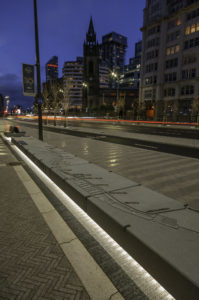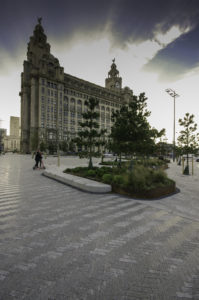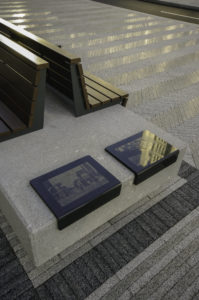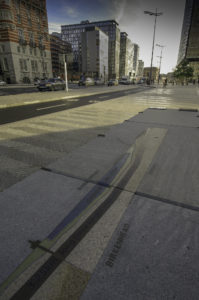Strand and Delivered

The Strand is at the epicentre of Liverpool and surrounded by Grade II listed buildings. The two-kilometre street is a major artery connecting locals and tourists to the historic Waterfront, the Queensway Tunnel, James Street railway station, Mersey ferries, public spaces, retail, and restaurants.
Untouched in its layout since the 1950s, when the city’s Overhead Railway was dismantled, the radical redesign of The Strand has seen the removal of several junctions and a lane reduction in both directions as part of a bid to improve traffic flow, pedestrian safety and air quality levels.
Following the success of ‘The Voyage’ in re-imagining part of Liverpool’s key waterfront street as a positive place for people (rather than just cars), in 2016 BCA landscape were appointed alongside engineering consultants AMEY to expand this high-quality vision along the whole city centre waterfront encompassing the core values which were developed in the first phase of the project.
Phase one of The Strand runs from Leeds Street to James Street, past the city’s world famous Three Graces to the former White Star line building where The Titanic was designed. The Strand project is part of a bigger regeneration plan – the £47m Liverpool City Centre Connectivity (LCCC) scheme.
The regeneration project aimed to:
- Reduce congestion, enable and promote pedestrian/cycling safety and the implementation of green infrastructure. To improve air quality by reducing traffic and increasing tree canopy, thereby reducing carbon emissions and other pollutants.
- Be human-centric and environmentally conscious. It is a public realm streetscape project that adheres to European Commission guidelines on water and air quality. The project, however, did not separate the two priorities; rather, it combined them.
Investing in Green Infrastructure and Research for Improving Air Quality

Liverpool’s regeneration is one of three projects taking place in major cities around the world, including Valladolid in Spain and Izmir in Turkey, and is managed by Urban GreenUp, a project funded by the European Union’s Horizon Europe 2020 programme. Urban GreenUP strives to mitigate climate change and improve air and water quality with nature-based solutions. There are four categories that Urban GreenUp are using to achieve this: re-naturising urbanisation; singular green infrastructure; water interventions; and non-technical interventions.
The significant redesigning of how key junctions are used ensures that the traffic flow is more fluid, meaning less air pollution as cars are not stopping starting so frequently. Cycle lanes were incorporated in the design as a permanent, segregated cycle lane alongside the sidewalk, with a partition of trees separating cyclists from the road.
The newly planted trees take the form of a tree Sustainable Urban Drainage System, making use of a paving system and diversion of any excess surface water on the carriageway/cycleways, which will be diverted into the tree pit and tree watering system. This will both reduce the excess water to going into the already stretched drainage system and help reduce localised flooding pressure during periods of heavy rainfall.
The water quality is to be monitored before entering the system and once expelled by Liverpool University over several years to better understand how SUDS systems can future proof our cities with the intention of publishing the data to an international community to maximise the fight against climate change.
The regeneration of The Strand exemplifies the very best of green infrastructure projects, providing data and analysis for storm water and air quality, keeping us connected via safer walkways, cycle lanes and improved traffic flows, and introducing large canopies of trees while preserving the city’s heritage.
Several Objectives of the Re-structuring Project

Andy Thomson of BCA Landscape explains: ‘The aim of this revamping project was to improve air quality and connections for cyclists and pedestrians at the same time. Another consideration was to reduce the risk of flooding by planting new trees and installing sustainable drainage systems. We wanted the new paving material to merge the street view and architecture, so the use of a single, light colour was essential’.
Choice of Kellen Breccia and Liscio Tagenta E
Andy: “We opted for the Kellen Breccia Tagenta E concrete slab from Hardscape. We needed a wide variety of textures and formats to enable the creation of a subtle and delicate picture which would harmonise with the splendid buildings and their sophisticated abundance of white stone. The Breccia concrete slab was selected mainly for its high quality and wear resistance, as well as its wide availability of formats. We also used the Kellen Liscio to complement the chevron pattern used in the layout.”
The flexible layout of materials on sand, including Hardscape’s Drainjoint permeable system, was another crucial factor for the sustainable approach to the design. Says Andy: “Hardscape’s Kellen paving material range have the right properties to meet all of these wishes and requirements, and the final result is splendid!”
IP Surfaces

Bespoke Granite Benches
Hardscape’s sister company, IP Surfaces Ltd, manufactured the benches for 2 sections of The Strand. The 1st section included 10 benches each where the granite block arrived from the European quarry cut to size (Grey Montemuro granite in a flamed finish). Each block was a massive 1200mm x 2000mm x 300mm weighing in at 2 tonnes.
IP Surfaces applied their skill sets and latest technology by using impact etching to create the Crystal Black granite skate stoppers which were placed at the ends of the benches, sandblasting to create recesses for the bronze inlays as well as creating recesses for painting and creating further pictorial artwork. The bronze was waterjet-cut which was then inlaid into the benches, which included painting some of the recessed (sandblasted) artwork pieces. A further process of CNC routing to the front and back of the benches and finally fixing bronze skate stoppers to the corners of benches. The 2nd section included 8 benches with each following the same detail as the 1st section.
Next Phase

Phase two of The Strand, which is set to begin in Spring 2022 will see a further 70 trees planted, will run from James Street to Liver Street, passing Liverpool One, The Royal Albert Docks and ACC Liverpool in Kings Dock. Work will also begin in 2022 to create new cycle lanes on Chapel/Tithebarn Street and Water Street, which will take cyclists from the waterfront to the Knowledge Quarter in the eastern district of the city centre.
Why Hardscape?
Hardscape have been providing paving material selection advice for 28 years to all designers, but in the main, Landscape Architects, involved with delivering multi-purpose external spaces throughout the UK, Europe and internationally. Hardscape’s core skills are borne out of their knowledge of technical properties of materials that will span a multi-lifetime service for any specific project function.
Hardscape’s product offer is a plethora of material types and dynamic too, to provide optimum aesthetic impact to suit each project’s aims. Hardscape’s social, ethical and sustainable responsibilities surround all of their activities and requires an understanding of an international suite of materials and the associated supply chain limits. Hardscape’s insight of tomorrow’s design demands is a huge part of their knowledge too, to ensure leading edge project outcomes, Hardscape’s relationship with their Dutch manufacturer are a huge part of their portfolio because they too always provide the optimum solution for every situation.
